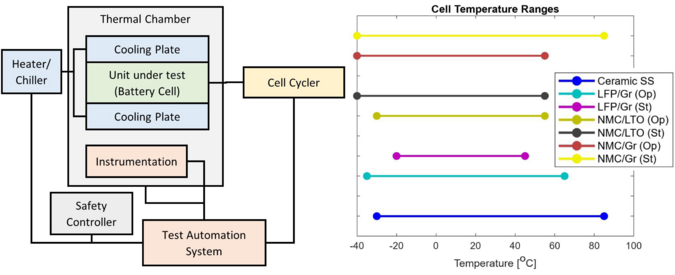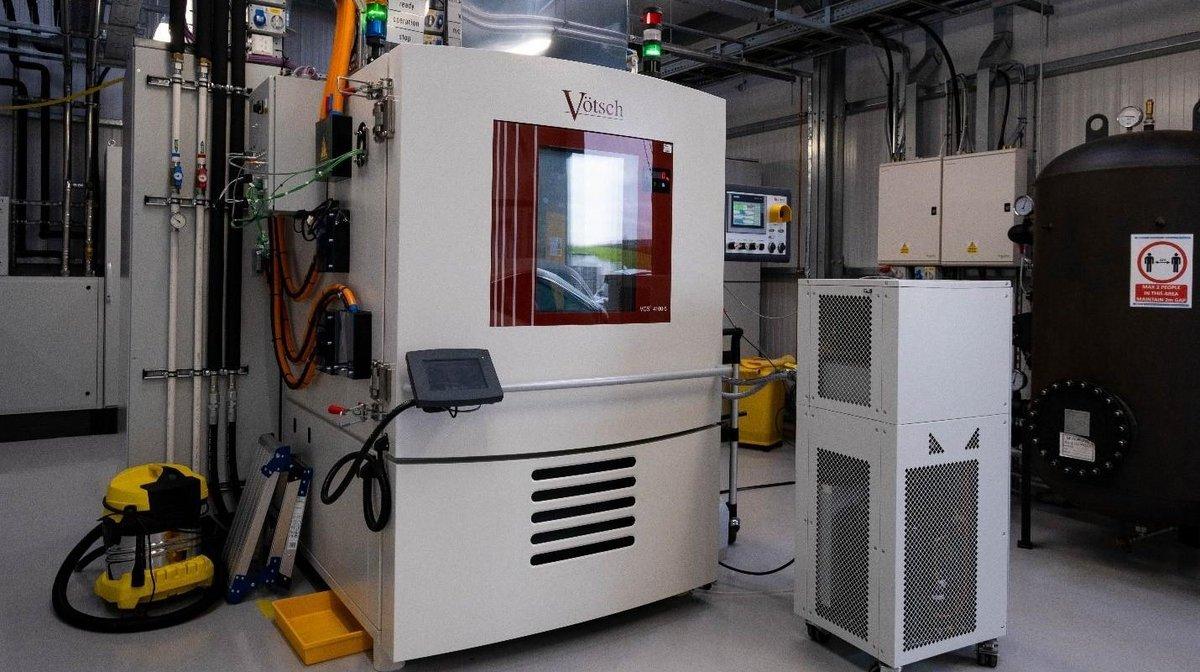
Battery temperature control is important during Li-ion cell testing. This type of battery is sensitive to temperature changes both in behavior and durability. Temperature variation can affect key performance characteristics such as capacity, resistance, and open circuit voltage (OCV). By controlling the temperature during testing through various conditions, these characteristics and their temperature dependence can be accurately evaluated.
Additionally, temperature control can impact the longevity of the battery during degradation tests through influencing chemical degradation mechanisms.
We have a range of experience in cell, module, and pack testing.
A key component of electric vehicle performance is effective battery pack design. To accomplish battery pack design, a range of tests are performed across cells, modules, and packs.
An overview of the different testing requirements across a battery pack development V-cycle (figure 1).
For these purposes, strict test condition control is important.
Battery cell characteristics such as capacity, open circuit voltage (OCV), and resistance depend significantly on state-of-charge (SoC), applied current, and temperature. The dependence of battery cells on these characteristics is unique to each cell model, and continuously varies non-linearly with ageing.
With no general relationship between cell behavior and condition, testing plays an important role in gathering the required information to understand and simulate cells for optimal design and control.
Module and pack designs introduce thermal systems to control battery cell temperatures. The effectiveness of the design needs to be validated in representative conditions to evaluate the effects on cell temperature variation and thermal gradients within a battery pack. This is particularly prevalent with durability testing, where changes in temperature of individual cells can cause ageing disparities after prolonged periods.
Temperature is the single most important factor in battery cell resistance magnitude.
The resistance can, on average, change by up to 40x across the usable temperature range (figure 2). This in turn can cause a significant variation in useable capacity with temperature (figure 3). This must be accounted for in control strategies or there could be unexpected power or range limitation during usage. The extent of the temperature dependence cannot be predicted, being unique for each cell. Temperature also affects OCV, dynamic voltage response, and durability.
For these reasons, the ability to test cells across the condition range is essential.
At a module and pack level, it is important to have representative thermal management. The in-vehicle thermal management will be limited to the capabilities on the on-board cooling/heating, which will in turn be limited by factors such as weight, size, and cost.
It is important to have controllability in the thermal setup to evaluate the influence of heating/cooling capability and the effects of degradation/ faults on the performance of the modules or packs under testing.
This is particularly important for durability testing, in which thermal gradients may lead to an ageing disparity within the pack gradually during usage.
 A temperature control setup includes both passive and active cooling for a battery cell setup (figure 4).
A temperature control setup includes both passive and active cooling for a battery cell setup (figure 4).
Passive cooling is provided by thermal chambers and active cooling is provided by heaters/chillers connected to the unit under test.
When specifying the thermal system, it is important to consider the temperature range in which your cell, module or pack is likely to operate.
Operational temperature ranges vary across cell chemistries and designs, with each model having unique recommended temperature ranges for operation and storage.
Example cell ranges are shown in Figure 5. It is recommended to choose equipment based on the full range of cell technologies expected to be tested.
The ambient temperature is typically controlled by thermal chambers. These chambers also serve an additional function of device containment in the event of thermal runaway.
There are many options for chamber selection, the optimal choice depends on:
It is also important to be able to remove heating generated from the device-under-test effectively.
This is typically performed by a chiller unit with the relevant interfacing to the device. There are a range of possibilities for this, and the best selection depends on a range of criteria:
The selection of the right equipment is made difficult, as the values relating to the device under test may not be known before the testing has commenced.
There are many considerations when selecting the right equipment to help maintain thermal management, and it significantly depends on the characteristics of the device under test. At HORIBA Automotive we have a library of cells purposely characterized to give a range of data sets for facility sizing.
We also have expertise from global testing facilities including HORIBA MIRA (UK) and E-Harbor (Japan), which provide real-world testing experience for developing testing facilities.
This experience has helped develop world leading test equipment and test automation systems and can be used to help customers develop highly effective testing solutions.
Sie haben Fragen oder Wünsche? Nutzen Sie dieses Formular, um mit unseren Spezialisten in Kontakt zu treten.

